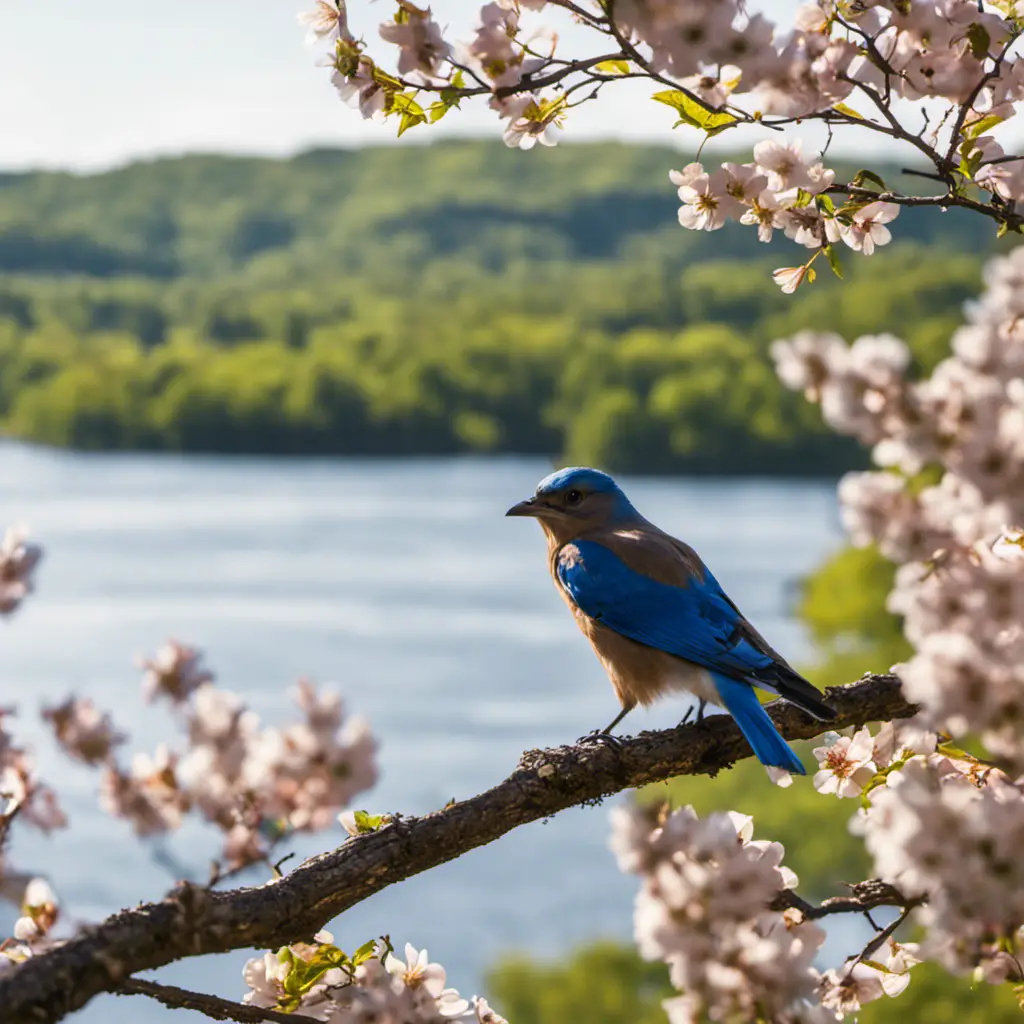Montana is known for its diverse wildlife, including a range of bird species. Some of the most common birds found in Montana include bald eagles, great horned owls, American kestrels, and rock pigeons.
We’ll introduce the most commonly seen birds in Montana with pictures and key data. The information was collected from reliable sources only, such as verified field guides and Ornithologists.
Common Backyard Birds of Montana:
American Robin
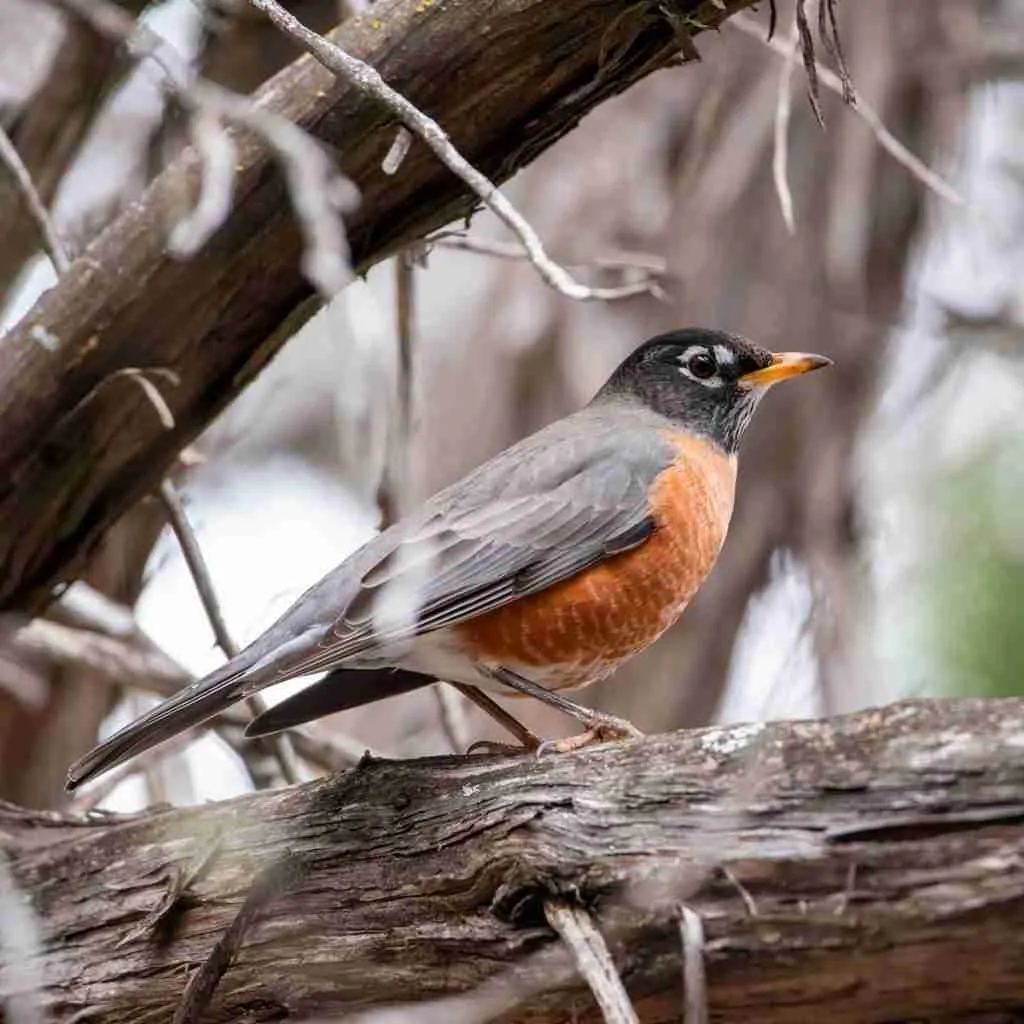
(Turdus migratorius)
The American Robin is a familiar sight across North America, with its bright orange-red breast and cheery chirp. It can be identified by its gray upperparts, white underparts, and black head with a distinctive yellow bill.
These birds primarily feed on worms and insects found on the ground, but will also consume fruit and berries.
The American Robin can range in size from 9-11 inches in length, with a wingspan of 13-15 inches.
Their preferred habitats include open woodlands, yards, and parks. They are often seen hopping along lawns looking for food.
During the breeding season, the male American Robin is known for its elaborate courtship displays and territorial singing. These birds often build cup-shaped nests in trees to raise their young. They may also use man-made structures such as building ledges or hanging flower baskets for nest sites. Outside of the breeding season, they can often be seen in small flocks foraging for food.

Pine Siskin
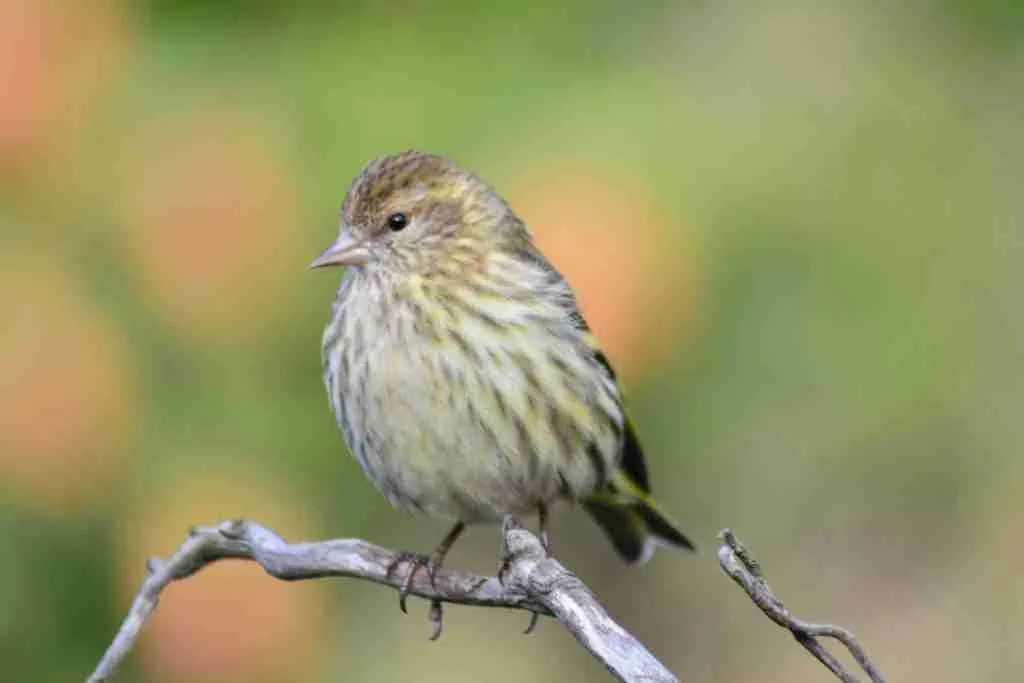
Pine Siskin, a small finch with brown and yellow streaked feathers, is commonly found in coniferous forests throughout Montana. These birds can often be spotted at bird feeders, where they mainly eat seeds and insects. Aside from their distinctive striped plumage, Pine Siskins also have a noticeable forked tail and pointed bill.
In terms of behavior, Pine Siskins are social birds that often travel in large flocks. They are known for their acrobatic flying abilities and high-pitched calls.

Cedar Waxwing
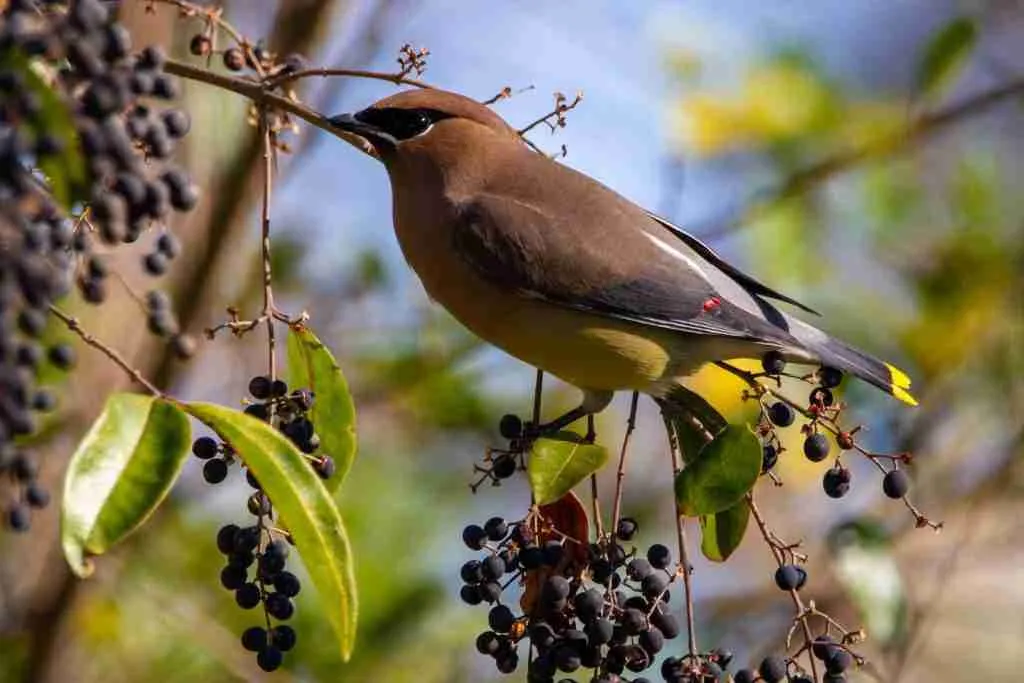
Cedar Waxwing is easily identified by their sleek, shiny brown bodies with yellow tips on their wings and a distinctive black mask on their face. They have a pointed crest on top of their head and a short, narrow beak. Their diet consists mainly of berries and insects.
Cedar Waxwings are medium-sized birds, about the size of a robin. They can be found in a variety of habitats, including forests, parks, and suburban areas.
In terms of behavior, Cedar Waxwings are social birds often seen in flocks. They have a unique method of eating berries where they will pass the fruit back and forth between each other before consuming it. They also have a tendency to “bathe” in the water by flying back and forth through a sprinkler or fountain.

European Starlings
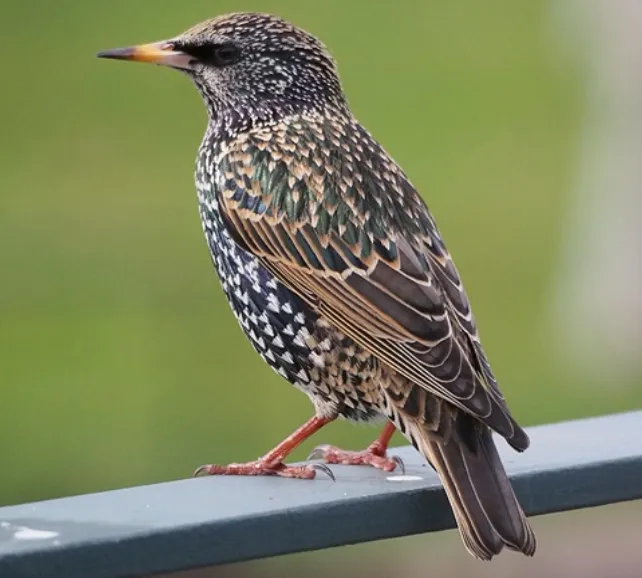
European Starlings, also known as Common Starlings, are small black birds with shiny feathers and speckles of white or green. They have a pointed yellow beak and long legs.
In the wild, their diet consists mostly of insects and berries. However, they are opportunistic feeders and will also eat bread crumbs or other human-provided foods.
These birds are about the size of a robin, measuring approximately 8 to 9 inches in length and weighing 1.4 ounces.
In Montana, European Starlings can be found in open fields, parks, farmland, and suburban areas. They are often seen foraging on the ground or perching on utility lines and buildings.
These birds are highly social and can often be seen in large flocks. They have a diverse repertoire of calls and songs and are known for mimicking the sounds of other birds and even mechanical noises.
European Starlings are considered invasive species due to their aggressive behavior towards native cavity-nesting birds, such as bluebirds and woodpeckers. They have also caused damage to crops and infrastructure. Despite this, they continue to thrive and can be found in many regions across North America.

Mourning Doves
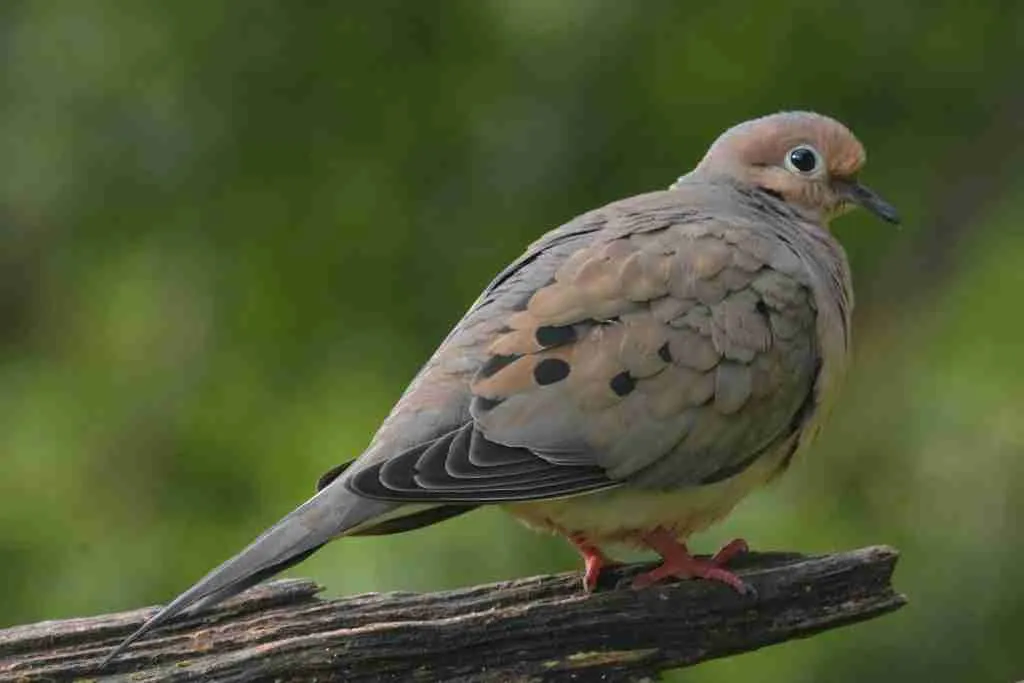
Mourning Doves are easily identifiable by their soft gray and brown plumage, long slender tail, and distinctive mournful call. Their diet consists mainly of seeds, but they will also eat insects and fruits. On average, they measure around 12 inches in length with a wingspan of 18 inches.
They can be found in a variety of open habitats such as fields, parks, and suburbs. Mourning Doves are generally peaceful and social birds, often seen in pairs or small flocks. They build flimsy nests made of twigs to raise their young.
These birds have a unique mating ritual where the male will fly high into the air and then dive down towards the female with wings pressed against their body, making a loud “wing whistle” sound.
Additionally, they have the ability to drink by sucking water into their beak and throwing back their head, rather than immersing their entire bill like most birds do.

Black-capped Chickadees
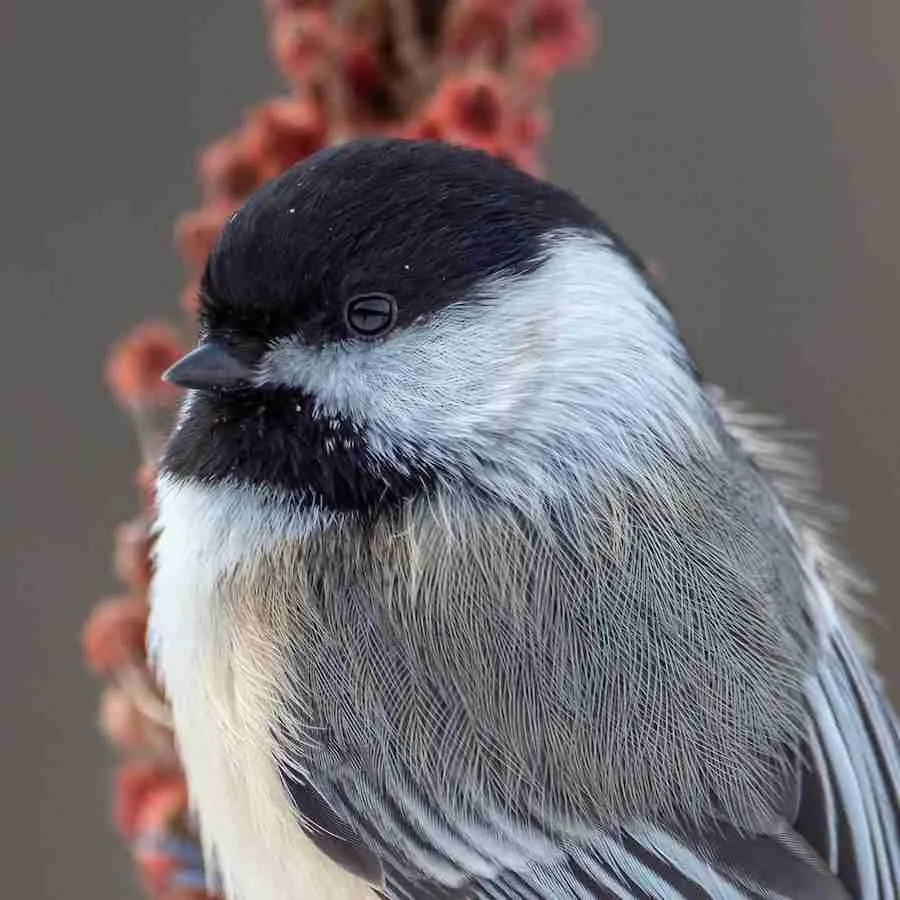
Black-capped Chickadees, a common sight in Montana, can be identified by their black cap and bib with white cheeks. They have a varied diet consisting of insects, black oil sunflower seeds, and suet.
These small birds typically measure 4-5 inches in length and can be found in forests, shrublands, and urban areas. Chickadees are known for their playful behavior, including hanging upside down and bathing in water or dust.
They also have a distinct call consisting of the well-known “chick-a-dee-dee-dee” sound. In winter, chickadees often form flocks with other small birds and can be seen visiting a bird feeder.

Western Meadowlark
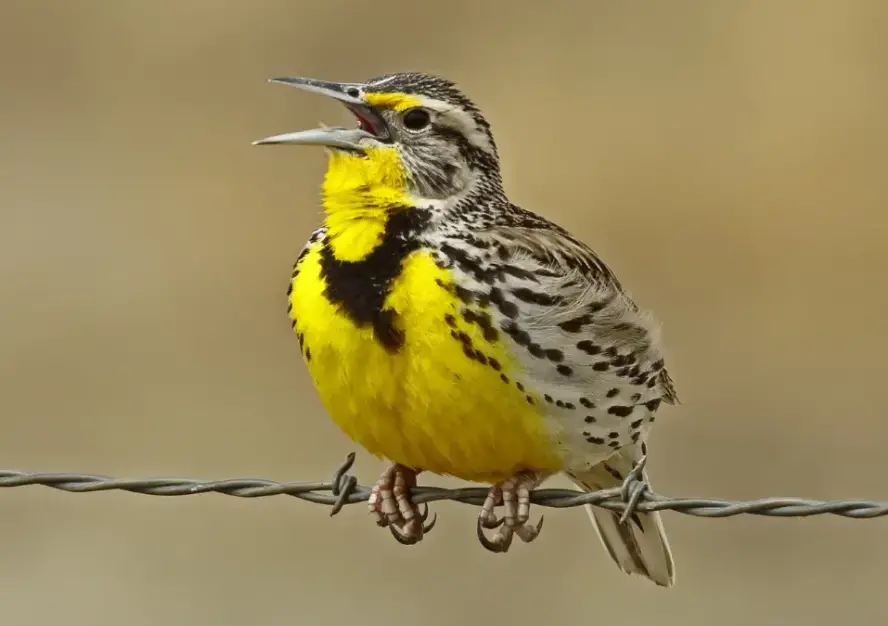
(Sturnella neglecta) can be identified by their yellow underbelly, black V-shaped bib on their chest, and a long pointed bill. They mainly eat insects, small vertebrates, and seeds. These birds have an average length of 9-11 inches and can be found in grasslands, agricultural fields, and open woodlands.
Western Meadowlarks are known for their beautiful songs and often sing while perched on a fencepost or other elevated perch. They also perform an interesting display where they spread their tail feathers and fluff up their body feathers to attract a mate.
While these birds can be found year-round in Montana, some Western Meadowlarks do migrate to southern states during the winter. They typically form monogamous pairs and build cup-shaped nests on the ground, where the female will lay 3-6 eggs.
Both parents take part in incubating and raising the young. However, their populations have declined due to habitat loss and changes in agricultural practices. Conservation efforts are important for protecting these beautiful songbirds.

Black-billed Magpie

Black-billed Magpie is a large black and white bird with iridescent blue-green patches on its wings and tail. Its diet consists of insects, small mammals, berries, and garbage from human habitation.
They can be found in open areas such as grasslands and agricultural fields. In terms of behavior, they are highly social birds often seen foraging in flocks and building communal nests. They are also known for their intelligence, problem-solving abilities, and mimicry of other bird species’ calls.

Eastern Kingbird

Eastern Kingbirds, also known as tyrant flycatchers, can be identified by their gray body, white underbelly, and black tail with white edges. These birds primarily eat insects but will also eat berries and fruits. Eastern Kingbirds typically measure about 9 inches in length and have a wingspan of 13-15 inches.
They can be found in open woodlands, fields, and wetlands. In terms of behavior, Eastern Kingbirds are known for their territorial nature and will aggressively defend their nesting area from intruders. They also have a unique mating ritual in which the male bird presents food to the female while performing acrobatic flight displays.
Eastern Kingbirds can be found throughout Montana during the summer breeding season but will migrate south for the winter. They are commonly seen perching on top of trees and utility poles, scanning for prey to catch in mid-air.
These birds play an important role in controlling insect populations and make a valuable addition to any backyard birdwatching list.

Red-winged Blackbird
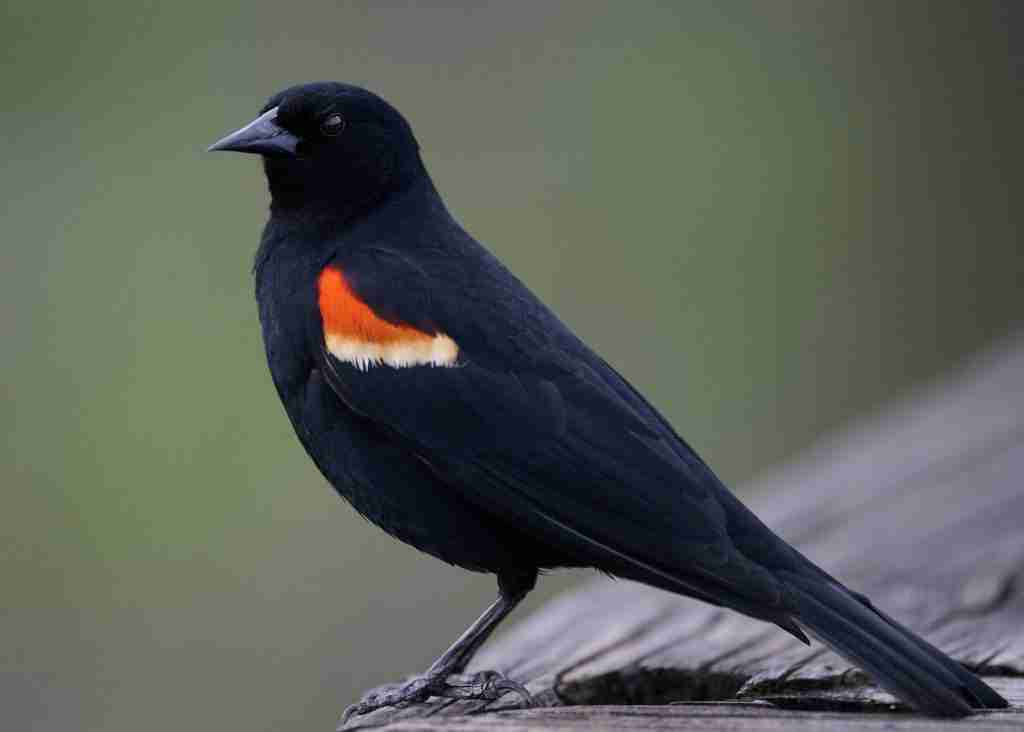
(Agelaius phoeniceus) can be identified by their black feathers with distinct red and yellow shoulder patches. They mainly eat insects, grains, and seeds. The average size of a Red-winged Blackbird is 9-11 inches in length with a wingspan of 13-17 inches.
These birds can be found in a variety of habitats including marshes, wetlands, grasslands, agricultural areas, and even suburban areas.
Their behavior includes defending their territory by singing and displaying their shoulder patches as well as engaging in communal nesting and roosting. They also form large flocks during migration and winter seasons.

Northern Flicker
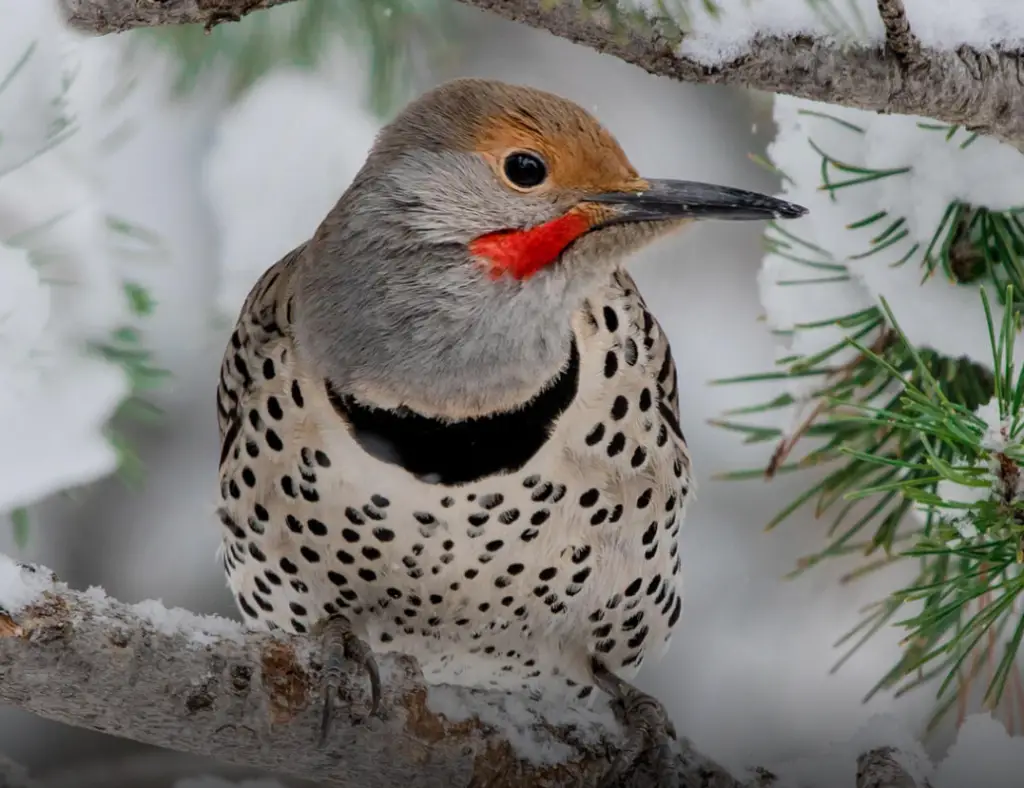
Northern Flicker woodpeckers can be identified by their black and white barred backs, brown crowns, and red crescent markings on their chests. They primarily feed on insects and fruits, particularly ants.
On average, they measure approximately 11-12 inches in length and have a wingspan of 16-20 inches. Northern Flicker woodpeckers can be found in open woodlands and parks, sometimes even venturing into urban areas.
Their behavior includes excavating nests in tree trunks and foraging on the ground for food. They are also known to drum on objects like metal pipes or wooden fences to mark their territory.

Eurasian Collared-Doves
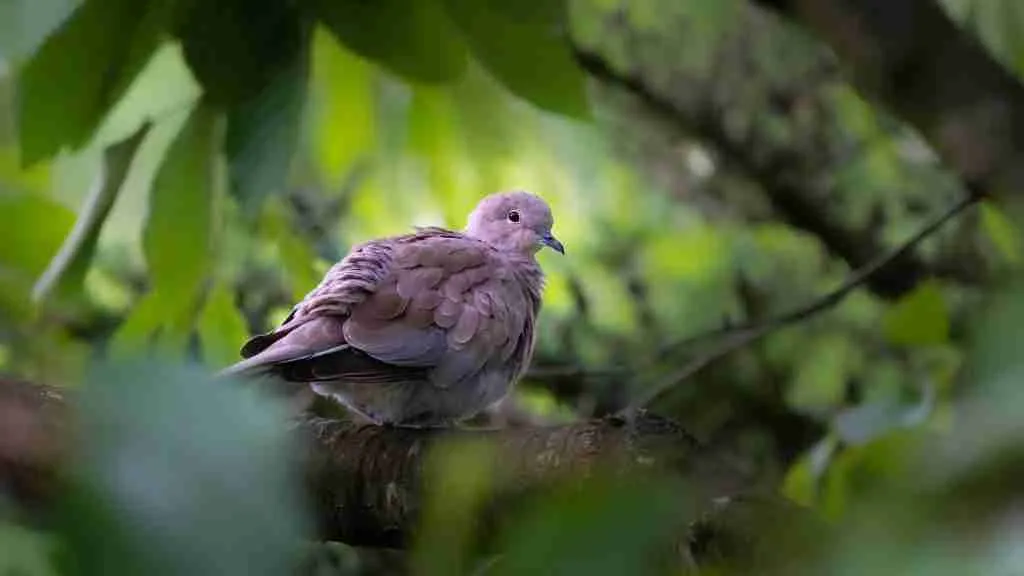
Eurasian Collared-Doves have distinct black and gray plumage with a tan collar on their neck. They mostly eat seeds, grain, and small insects.
These birds typically measure around 12 inches in length and can be found in open areas including fields, parks, and suburbs. Collared-Doves are social birds and often gather in flocks to forage for food. They are also known for their distinct cooing sounds.
These doves have adapted well to human environments and can be seen perched on power lines or bird feeders. However, their expanding population has led to them being considered pests in some areas as they compete with native birds for resources.

House Finch
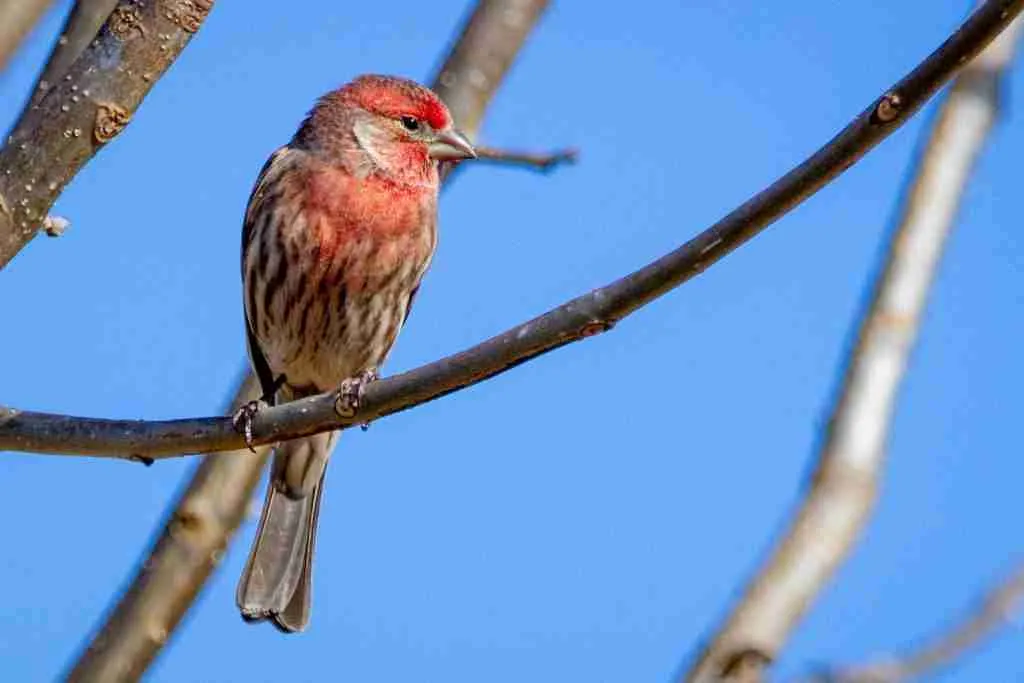
(Haemorhous mexicanus) can be identified by their red head and breast, brown back and wings, and white belly. They primarily eat seeds and grains but also feed on insects and fruit.
Adult House Finches are approximately 5-6 inches in length with a wingspan of 8-10 inches. They can be found in a variety of habitats, including suburban areas, open woodlands, and farmlands. These birds are social and often seen in small flocks.
They build cup-shaped nests in trees or on building structures and typically lay 3-6 eggs per clutch. House Finches are year-round residents in Montana and can also be found across much of North America.

Chipping Sparrow
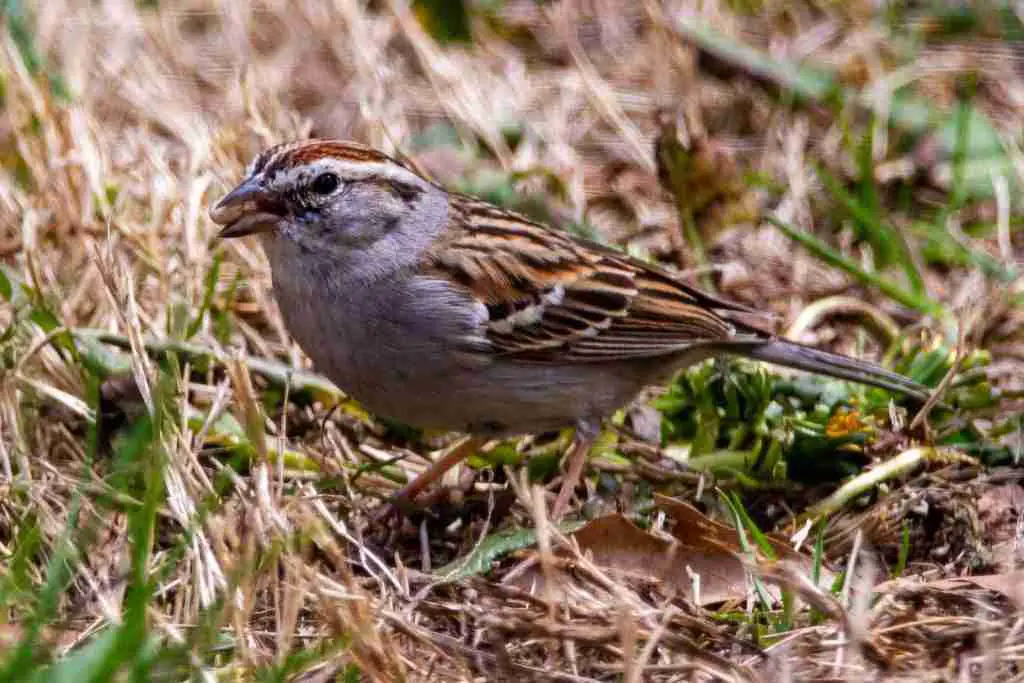
Chipping Sparrows have a black stripe through their eyes, brown upperparts, and white underparts. They mainly eat seeds and insects and can reach sizes of 4-5 inches in length. These birds can be found in open woodlands and fields, as well as residential areas.
Chipping Sparrows are often seen hopping on the ground while foraging for food. They also have a distinctive “chip” call, hence their name. Overall, these small birds are common throughout much of North America.

Brown-headed Cowbird
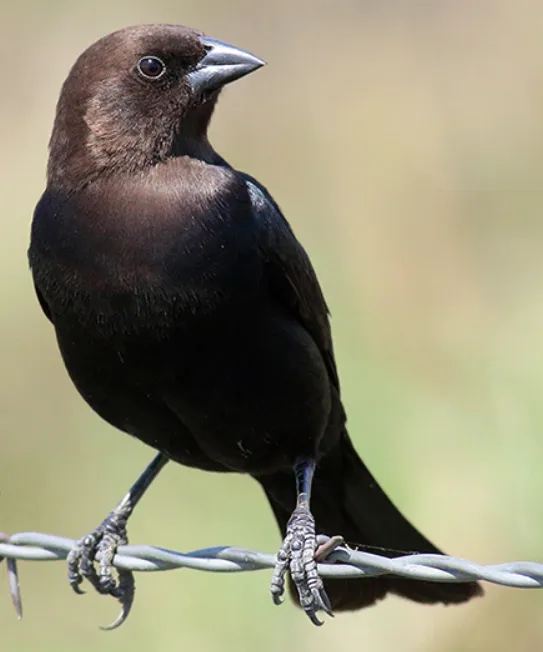
The Brown-headed Cowbird is a blackbird with a distinct brown head and glossy black body. They typically measure about 7.5 inches in length and weigh around 1.4 ounces.
These birds are opportunistic feeders and primarily eat insects, seeds, and grains.
They can be found in open areas with scattered trees such as grasslands, agricultural fields, and parks.
Brown-headed Cowbirds are known for their parasitic breeding habits, laying their eggs in the nests of other bird species and leaving the incubation and care of their young to the unsuspecting host. They will also aggressively chase away the nesting birds from their own nest. This behavior has caused declines in some host bird populations.
In the winter, Brown-headed Cowbirds often form large flocks with other blackbird species and can be seen foraging on the ground together. They are also known to follow herds of bison and cattle, taking advantage of insects stirred up by their movements.
Due to their parasitic breeding habits, the Brown-headed Cowbird is often considered a nuisance species. However, their presence can also indicate a healthy and diverse habitat. Conservation efforts for this species focus on protecting and maintaining suitable habitats as well as educating the public about the potentially harmful effects of feeding these birds at backyard bird feeders.

House Sparrow
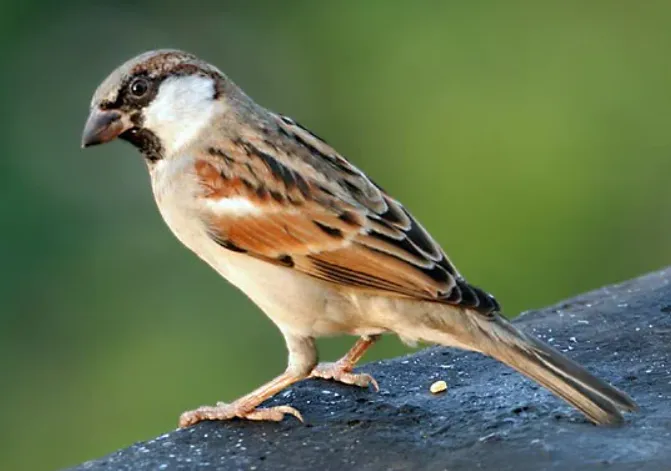
House Sparrows can be identified by their small, stout bodies and gray-brown feathers. They have a distinctive black patch on their throat and a white outer tail.
Their diet consists mainly of seeds and grains, but they will also eat insects and even small frogs or lizards.
These birds are usually about 6 inches in length and can be found in a variety of habitats, including urban areas and farmland.
In terms of behavior, House Sparrows are known to be aggressive towards other birds and will often claim nesting sites by force. They also form large flocks and can be seen flying in formation.

House Wren
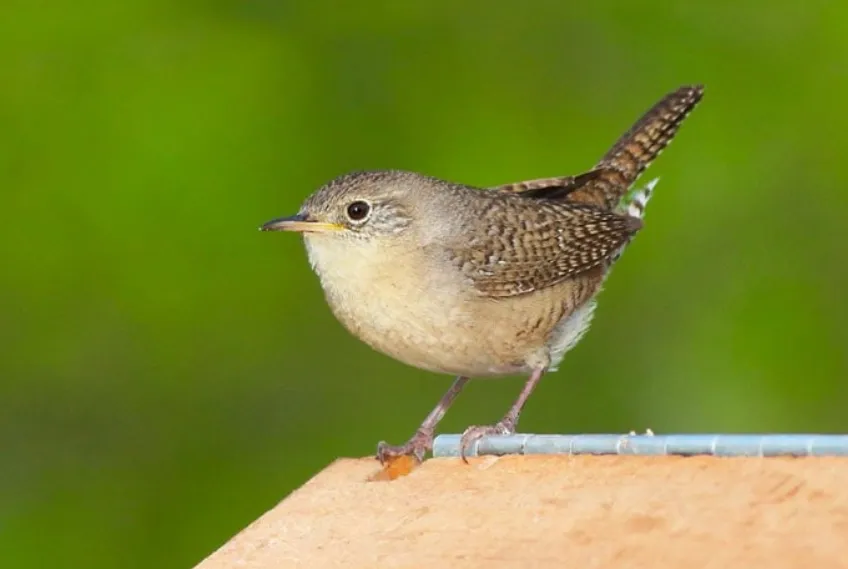
House Wrens, found in Montana, has a distinct appearance with brown plumage, white cheeks, a short tail, and a long bill. These small birds primarily eat insects such as beetles and caterpillars. They can be found in open woodlands, residential areas, and farmlands.
Look for them perching on branches or foraging on the ground. They are known for their loud and complex songs, as well as their nest-building behavior where they often gather and place materials such as twigs in multiple potential nesting sites.
House Wrens also have a territorial nature and may try to evict other birds from nest boxes or cavities. This behavior can even extend to objects like hanging flower pots or boots. They may also be aggressive towards larger birds, such as bluebirds and owls. This territorial behavior often peaks during the breeding season.

Mountain Bluebird
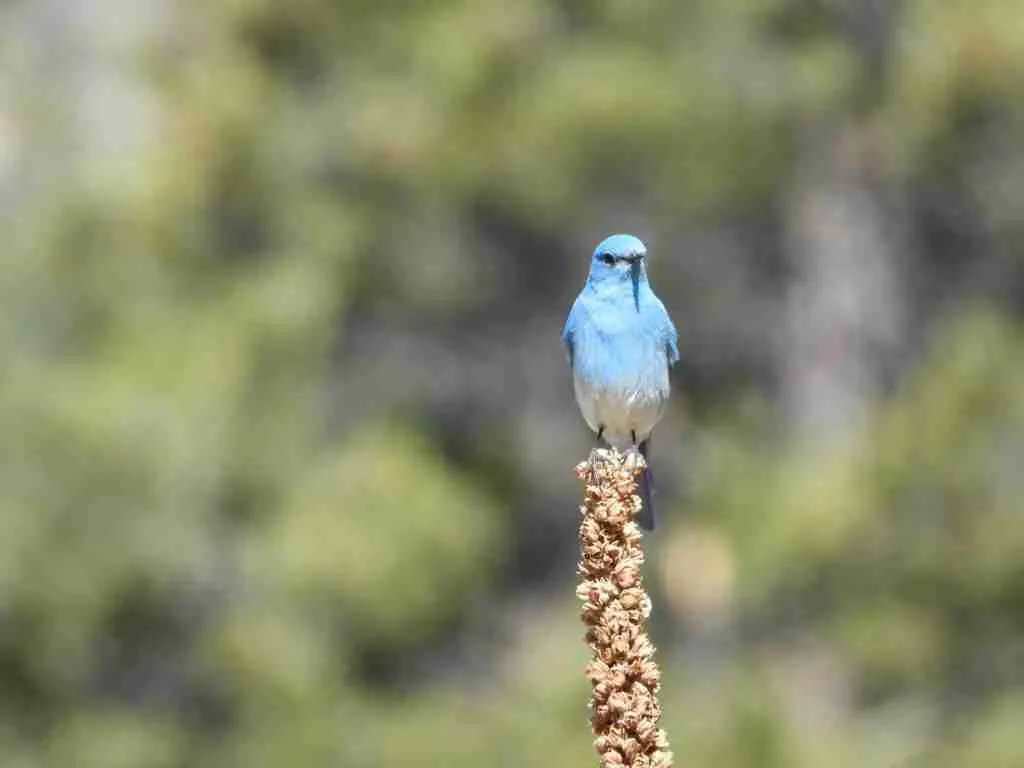
Mountain Bluebird, a member of the thrush family, can be identified by its brilliant blue feathers and orange breast. This bird primarily feeds on insects and berries. It has an average length of 6-7 inches and prefers open habitats such as grasslands and mountain meadows. Mountain Bluebirds are known for their graceful flight patterns and territorial behavior during mating season.
They build cup-shaped nests in tree cavities or man-made nest boxes. This bird is a symbol of happiness and good luck in many Native American cultures. Conservation efforts have been successful in increasing the Mountain Bluebird population in recent years.
However, they are still threatened by habitat loss and competition for nest sites with invasive species such as European Starlings. It is a delight to spot this beautiful bird in its natural habitat.

Red-breasted Nuthatch
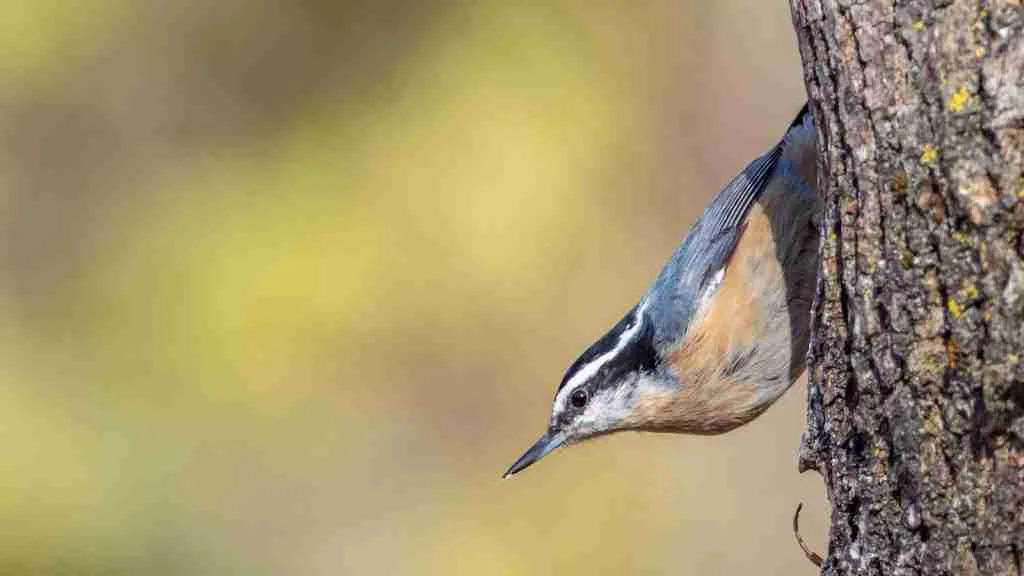
Red-breasted Nuthatch is a small songbird with a white face and chest, gray back, black crown, and reddish-orange underparts. They have a long pointed bill used for digging and extracting insects from tree bark.
In Montana, Red-breasted Nuthatches can be found in coniferous forests throughout the year. They primarily eat insects and seeds, and will often store food in tree crevices for later consumption.
Red-breasted Nuthatches are known for their acrobatic behavior as they climb up and down tree trunks searching for food. They also have a distinct call consisting of short high pitched notes.

Common Grackle
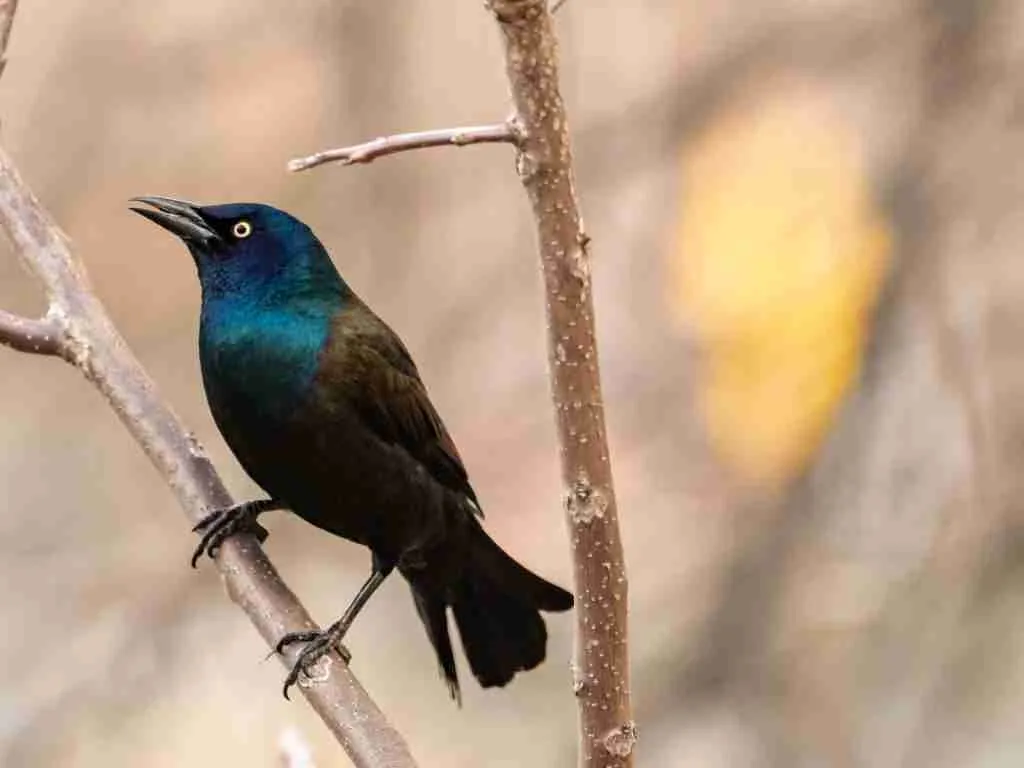
Common Grackle, a medium-sized black bird with iridescent feathers, can be found in Montana within open habitats such as fields, parks, and wetlands. They have a varied diet consisting of insects, grains, fruits, and small animals. Male Common Grackles can reach lengths of up to 11 inches, while females are slightly smaller at 9 inches in length.
In terms of behavior, Common Grackles are known to be social birds, often seen in large flocks. They have a reputation for being aggressive towards smaller bird species and have been known to steal food from other birds or scavenge at outdoor eating areas.

Savannah Sparrow
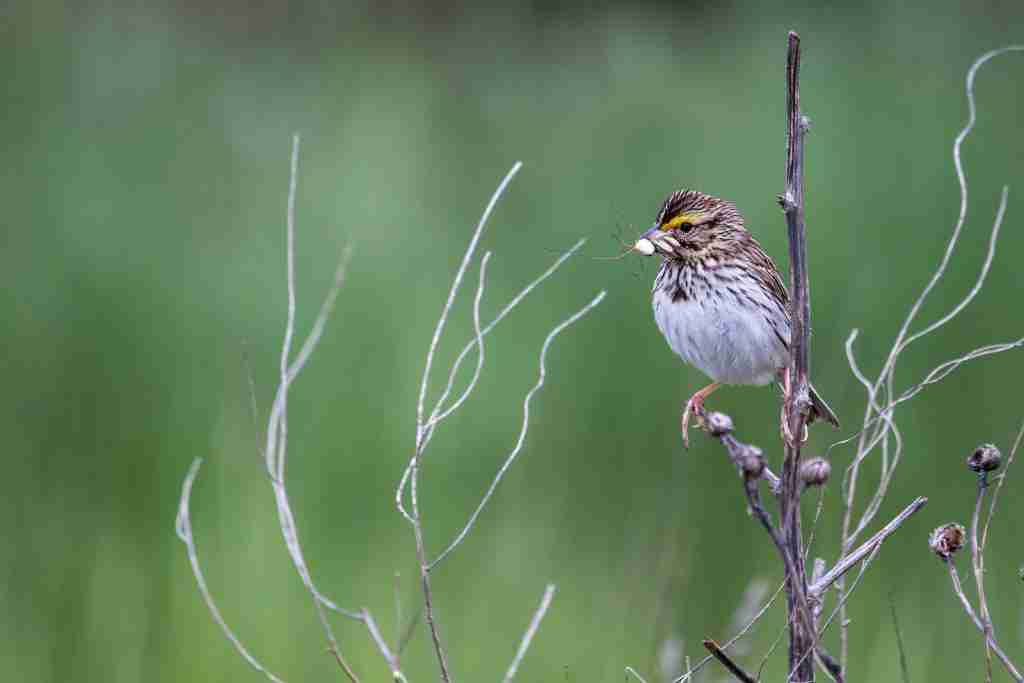
Savannah Sparrows can be identified by their striped crown, yellowish wash on the breast, and white outer tail feathers. They mainly eat insects and seeds, but will also consume berries and nectar. These sparrows typically grow to be around 4-6 inches in length.
In Montana, they can be found in grasslands and marshes.
During the breeding season, male Savannah Sparrows will establish and defend their territory by singing and performing flight displays. They build their nests on the ground, lined with grass and other plants.
Outside of the breeding season, they often form large flocks with other sparrow species. Overall, they are fairly common and widespread throughout North America.

Ruby-crowned Kinglet
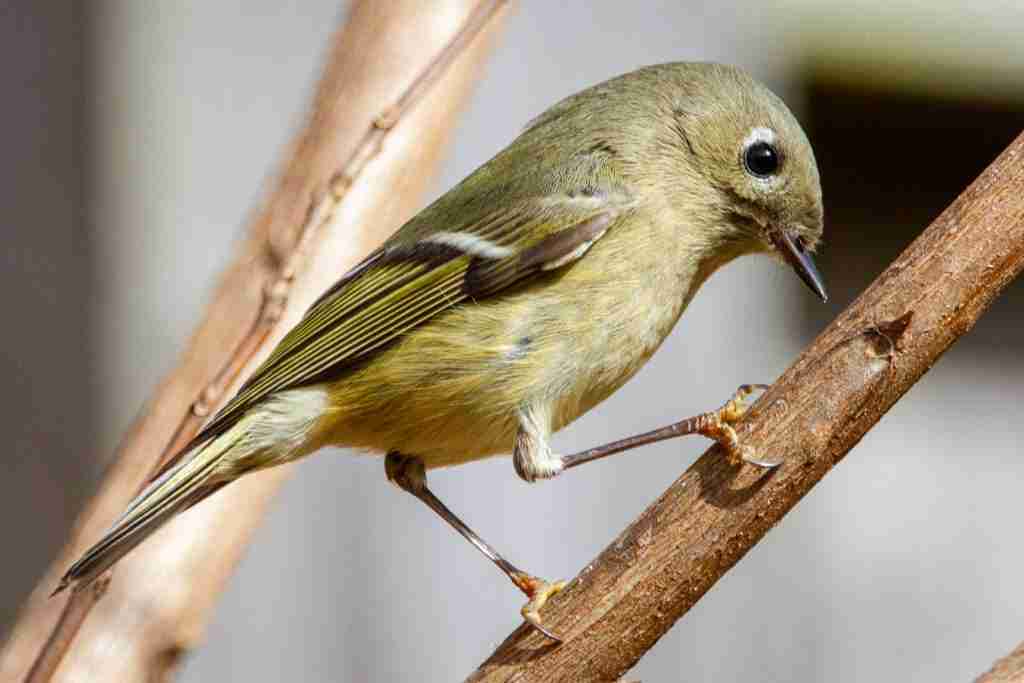
Ruby-crowned Kinglet is a small songbird with olive-green upperparts and pale gray underparts. It has a distinct red patch on its crown, which is only visible when the bird is agitated or displaying to potential mates.
These birds primarily eat insects, but will also feed on seeds and berries.
They typically measure around 4 inches in length and have a wingspan of 6-7 inches.
Ruby-crowned Kinglets can be found in coniferous forests during the breeding season and in mixed woodlands during migration and winter.
These birds are very active, constantly foraging for food through foliage and twig tips. They also have a habit of flicking their wings while perched, a behavior known as wing shaking.
During the breeding season, male Ruby-crowned Kinglets perform a display flight called “quivering flight,” during which they sing and rapidly flutter their wings to attract a mate. They often form monogamous pairs and will defend their territory aggressively against intruders.

Hairy Woodpecker
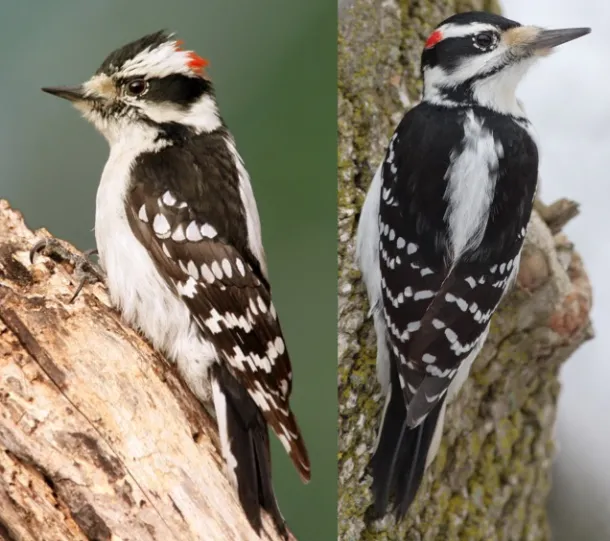
Hairy Woodpecker can be identified by its black and white coloration, with a distinctive red patch on the back of its head. Its diet consists mainly of insects and their larvae, which it forages for by pecking at tree bark.
Hairy Woodpeckers are approximately 9-10 inches in length and can be found in coniferous forests. They often make drumming noises by pecking on trees or metal objects, and also use this noise to communicate with other Hairy Woodpeckers. They usually nest in cavities in dead trees.
The Hairy Woodpecker is a year-round resident in Montana, but may be slightly more abundant during the winter months when other woodpecker species migrate. They are often seen alone or in pairs, but may also gather in small flocks during the winter. This bird can sometimes be seen foraging with other woodpecker species, such as the Downy Woodpecker.
In addition to their insect diet, Hairy Woodpeckers will also eat suet, seeds, fruit, and nuts at bird feeders. They have been known to store extra food by wedging it into tree crevices for later consumption. This behavior, along with their fierce determination when finding food, has earned them the nickname “the tenacious one.”

Common Yellowthroat

(Geothlypis trichas) is a small songbird with olive-green upperparts and bright yellow underparts. Its distinctive black mask makes it easy to identify.
In Montana, these birds can be found in wetlands, brushy areas, and open woodlands. They forage for insects on the ground or in low vegetation.
Common Yellowthroats typically reach lengths of 4-5 inches and weigh around 0.3 ounces.
During breeding season, male Common Yellowthroats are known to be territorial and will defend their territory by singing loudly and chasing intruders.
Outside of the breeding season, they can often be found in small flocks with other songbirds.

Belted Kingfisher

Belted Kingfisher, also known as Megaceryle alcyon, can easily be identified by its large size, blue back, white underbelly, and a conspicuous black-and-white band across its chest.
In terms of diet, Belted Kingfishers mainly eat fish which they catch by diving into the water from above. They also eat insects, crustaceans, and small amphibians.
Belted Kingfishers typically range in size from 11 to 14 inches in length with a wingspan of 18 to 22 inches.
These birds can be found near bodies of water such as lakes, rivers, and seacoasts. They also inhabit wooded areas near water sources.
In terms of behavior, Belted Kingfishers are solitary birds and can often be seen perched on branches over water, diving for food. They also have a distinctive loud, rattling call.
Belted Kingfishers typically mate for life and excavate their nests in banks or cliffs near water sources. Both parents take turns incubating the eggs and feeding the young.

Common Raven
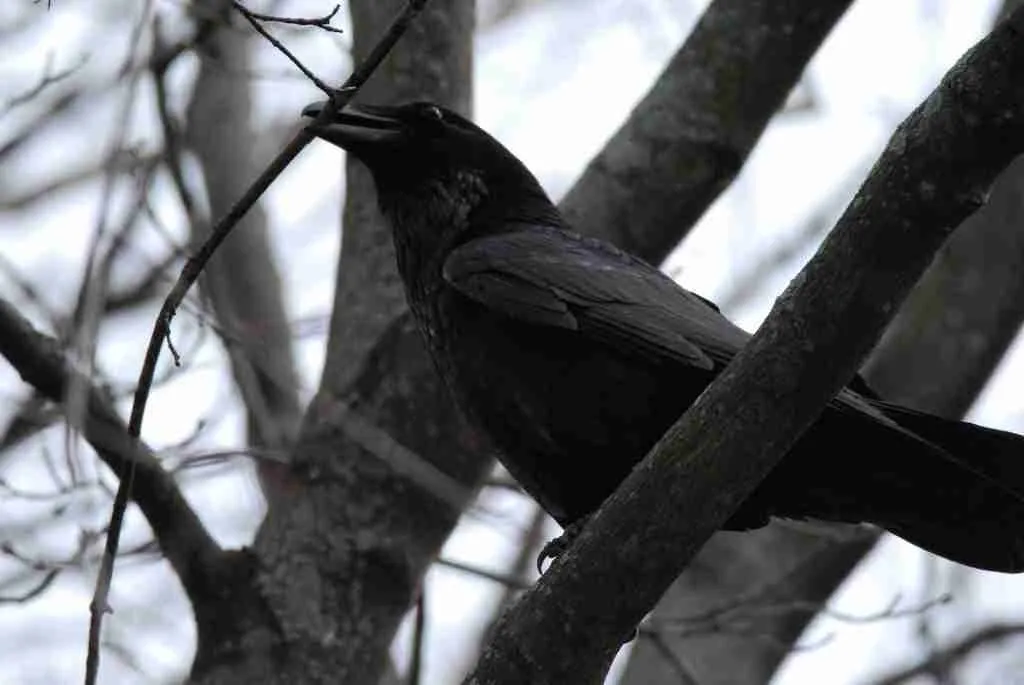
Common Raven, a large black bird found in Montana, can be identified by its distinctive deep croaking call and thick curved bill. Their diet consists of insects, carrion, grain, fruit, and other small animals. They can grow up to 24 inches in length with a wingspan of up to 46 inches. Common Ravens can be found in a variety of habitats, including forests, grasslands, and mountain areas.
They are known for their intelligence and problem-solving abilities, as well as their playful behavior such as creating and using tools. Ravens form strong pair bonds and often mate for life.
In Montana, Common Ravens can be seen congregating in large groups during the winter months. They often live in close proximity to human settlements, taking advantage of food sources and using buildings and trees for nesting sites. These adaptable birds play an important role in their ecosystems as both predators and scavengers.
However, they may also cause damage to crops and livestock, leading to conflicts with farmers. Despite this, Common Ravens are a protected species in the United States and their numbers remain stable.

Blue Jays
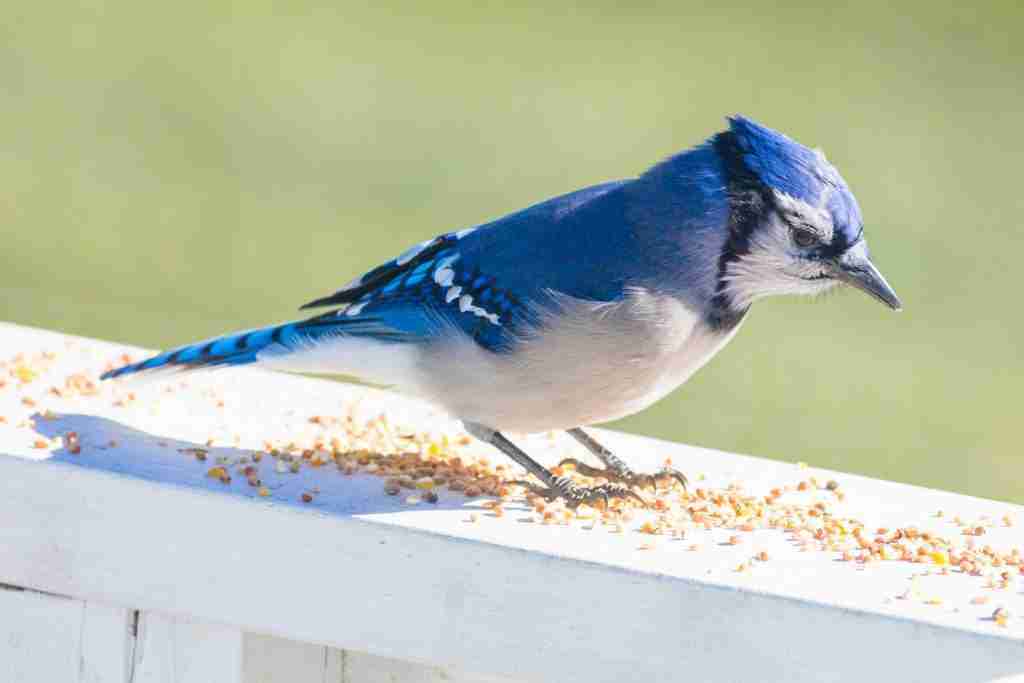
Blue Jays are easily identifiable by their bright blue plumage and crest on top of their head. They are omnivorous, often eating nuts, fruits, and small insects or vertebrates. Adult Blue Jays typically have a body length of 9-12 inches and a wingspan of 13-17 inches.
They can be found in both deciduous and coniferous forests, as well as suburban areas. Blue Jays are known for their intelligence and problem-solving abilities, as well as their loud and harsh calls. They have also been observed using tools and cooperating with each other to obtain food.
Additionally, Blue Jays are known for their behavior of “scatter hoarding,” where they gather and store food for future use.

Yellow Warbler
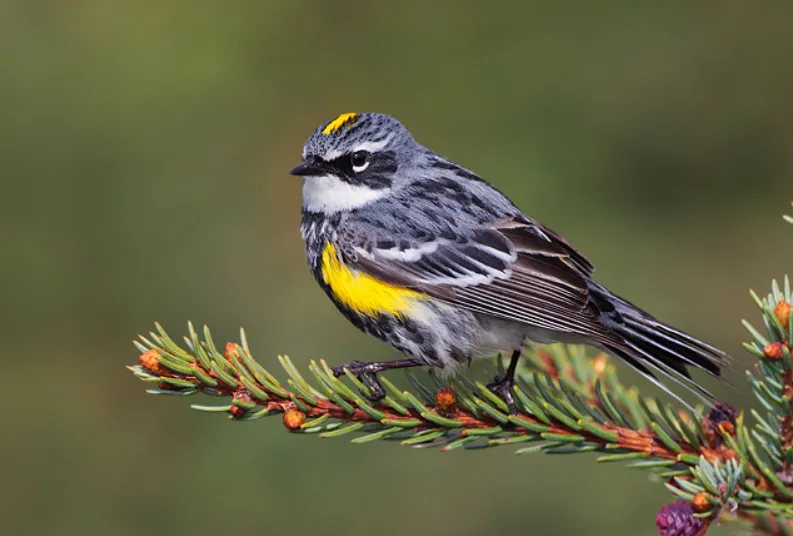
(Setophaga petechia) is a small songbird with yellow plumage, reddish streaks on its chest, and a dark line through the eye. It eats insects, berries, and seeds.
In Montana, Yellow Warblers can be found in wet meadows and thickets near water sources. They also inhabit deciduous woodlands and riparian areas.
During the breeding season, male Yellow Warblers establish territories and attract mates through their bright and musical songs.
They build cup-shaped nests using grass, leaves, and other plant materials, and females typically lay a clutch of four to five eggs. Both parents take part in incubating the eggs and feeding the hatchlings.
Outside of the breeding season, Yellow Warblers often travel in flocks and forage for food together. These birds migrate to Central and South America for the winter.

Mountain Chickadee
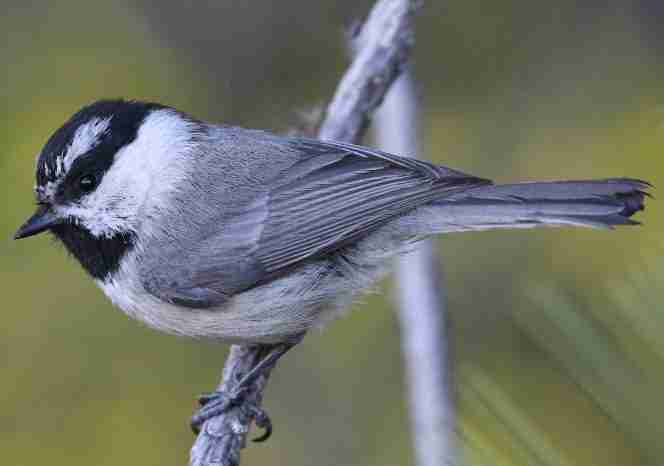
Mountain Chickadee, a small gray and black bird, can often be found in coniferous forests in Montana. These birds have a distinct black cap on their heads and white cheeks, along with a short stubby bill. They primarily eat insects and seeds, gleaned from tree trunks and branches. Mountain Chickadees can reach up to 5 inches in length and have a wingspan of 7 to 8 inches.
In addition to foraging alone or in flocks, these birds also engage in an unusual behavior known as “wanting.” They will rub insects, usually ants, onto their feathers, possibly for the chemicals the insects release.
Mountain Chickadees typically form pair bonds and nest in cavities, such as old woodpecker holes. They will also use nest boxes provided by humans. These birds are known for their loud, whistled “chick-a-dee” calls and can also mimic the sounds of other birds.

What are common birds in Montana?
Some common birds found in Montana include bald eagles, Canada geese, American robins, northern flickers, and western meadowlarks. Other common species include great horned owls, red-tailed hawks, killdeer, and blue jays.
Montana is also home to a variety of waterfowl such as mallards, common mergansers, and ring-necked ducks. Additionally, Montana is a popular destination for bird watching and offers opportunities to spot rare or migratory species such as the trumpeter swan and mountain bluebird.
How do I identify a bird in my backyard?
First, observe the bird’s physical characteristics, such as its size and color. Then, pay attention to its behavior and make note of any distinctive calls or songs. Finally, consult a field guide or use an online identification tool to narrow down potential species matches. With practice and patience, you will become more skilled at identifying backyard birds.
What is the most aggressive backyard bird?
It is hard to say definitively, as different species may exhibit aggressive behavior in different situations. However, some common culprits include blue jays, red-winged blackbirds, and American crows. These birds may attack smaller bird species or intruders on their territory, using their beaks and claws as weapons.
It is important for backyard bird enthusiasts to be aware of potential aggressive behavior in these species and take steps to prevent conflicts, such as providing multiple bird feeders and avoiding overcrowding at feeding stations.
Additionally, some birds may become more aggressive during nesting season, so it is important to be vigilant and provide appropriate space for nest-building.
Why are there no birds in Montana?
The lack of birds in Montana may be due to a variety of factors, including habitat loss, climate change, and human activity. The state has seen a decline in its bird population over the past several decades, with species such as the black-capped chickadee and evening grosbeak becoming increasingly rare.
Habitat loss, including the clearing of forests for development and agricultural expansion, has impacted bird populations in Montana. Additionally, climate change has led to shifts in bird migration patterns and the availability of food sources.
Human activity, such as the use of pesticides and hunting, can also play a role in decreasing bird populations. Conservation efforts, including habitat protection and regulation of hunting, may help to mitigate these impacts and support bird populations in Montana.
What is the black and white bird in Montana?
The most likely bird in question is the magpie. These birds are known for their black and white feather patterns and can be found throughout Montana. They are highly social birds and often seen in groups or flocks. In addition to their bold coloration, they are also known for their intelligence and problem-solving abilities.
Some Native American tribes viewed the magpie as a symbol of good luck. However, they can also be nuisance animals and are known to steal food or raid nests for eggs.
What birds stay in Montana for the winter?
Some common winter birds in Montana are the American robin, black-capped chickadee, northern shrike, and dark-eyed junco. Other bird species that may be seen during the winter months include bald eagles, great horned owls, and various waterfowl such as ducks and geese. These birds either live year-round in Montana or migrate to the state for the winter season.

An avid ornithologist, zoologist and biologist with an unwavering passion for birds and wild animals.
Dr. Wilson’s journey in ornithology began in childhood and led him to obtain a Ph.D. in Ornithology from the prestigious Avian Research Institute. He has worked closely with renowned experts in the field and conducted extensive research and field studies globally.

